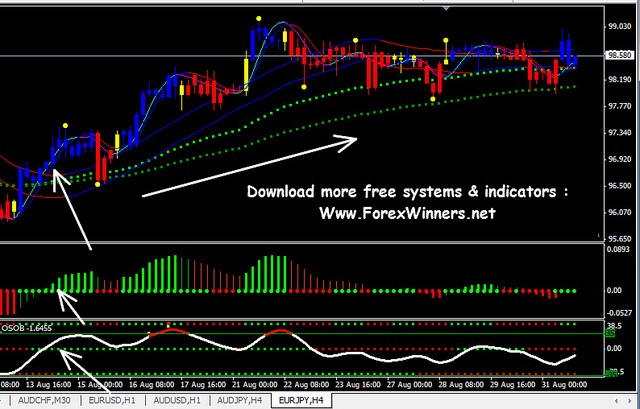Steps To Create A Mechanical Forex Trending Trading System
Post on: 30 Март, 2015 No Comment

Written by John Klain
A mechanical forex trending trading system is mainly based on technical indicators and a set of rules to enter and exit trades. Trending systems will only perform well in trending currency markets. Rarely will you get one forex system that is able to exploit both ranging and trending markets.
A mechanical forex trending trading system should attempt to accomplish 2 goals:
1. Be able to identify a new trend as soon as possible
2. Confirm this trend to avoid most false break or whipsaw signals
8 Steps To Create and Trade A Mechanical Forex Trending Trading System
The main focus of this article is to guide you through the process of developing your own mechanical forex trending trading system. Let’s move to step1.
If you want to create a mechanical forex trading system, the first step in the whole process is to decide which timeframe you want to use. What is the right time frame? Well, it all depends on your personality. You have to feel comfortable with the time frames you are trading in. Ask yourself the following question: Are you a scalping, short, swing, position or long-term currency trader? How many hours do you want to dedicate to forex trading?
This will help determine which time frame you will use to build your trading system. Picking the right chart timeframe will be covered in the next tutorial lesson.
Step 2: Find technical indicators that help spot a NEW trend.
A very popular overlay indicator among currency traders to spot new trends early are moving averages, a simple currency trending trading system to identify new trends is the moving average cross-over system, this trading system combines 2 moving averages, the long-term and the short-term to create a buy ar sell rule, when the short term MA crosses the long term MA from below, this will generate a buy signal, conversely, when the short term MA crosses the long term MA from above, this will generate a sell signal.
In it’s simplest form, moving average crossovers are the fastest ways to identify new trends. It is also the easiest way to spot new trends. The MA Cross System will work very well in trending markets but problems occur during ranging markets.
It is during these trading ranges that the MA systems show their weaknesses by generating false breakout signals and eating your profits. The best recommendation is to use MA Cross Systems only during trending market conditions.
How do we know the market is in a trend or not? By adding a trend confirming technical indicator.
Step 3: Find technical indicators that help CONFIRM the new trend.
In order to avoid most false breakouts and whipsaws, we have to confirm the new trend by adding a trend-confirming indicator such as MACD or ADX to our MA Cross trending system. Basically, adding ADX or MACD to our system is a method of determining if a market is trending or not.
For example, an increase of the ADX for example signifies that the market is trending, either up or down. A decreasing ADX can indicate that the trend is decreasing or moving into sideways action. As a general rule, if the ADX > 25 for MA systems, the new trend is confirmed and the trade should be taken.
Hundreds of indicators can help to confirm new trends, as you become more familiar with various technical indicators which you can find at our website or in our download section . you will find ones that you prefer to use over others, and can incorporate those into the MA trending system.
How does our MA-ADX system look like?
Step 4: Define your entry rules
When to enter the market? Simple, enter the market when your system signals a buy or sell order. In our MA system, entry rules would look like:
1) Buy at market if EMA(5) CrossOver SMA(200) from below and ADX>=25
2) Sell at market if EMA(5) CrossOver SMA(200) from above and ADX>=25
Step 5: Define your exit and target rules
When to exit the market? Basically, you have to exit the market only when the new trend is over, either with a loss or a profit. It is very important to understand and accept that your trending system will generate losses too. Taking profits can be done in many ways and it is just a matter of your trading style.
Some examples:
1) Use a trailing stop-loss to lock in profits meaning that if the currency price moves in your favor by Z amount, you move your stop by Z amount.
2) Close 1/2 of your position if the trade moves ‘Y pips in your favor, or close the trade completely if the price moves 100 pips in your favor.
3) Choose support and resistance levels as target levels.
4) Simple wait to take profits when your system tells you to do.
In our MA-ADX system, basic exit rules would look like:
- Exit the market if:

- Stop-loss has been hit
Step 6: Define your money management rules
As a general rule: Your risk per trade should never exceed 2% of your total equity. For example, if your total equity is $100,000, your risk per trade should never exceed $2000. Most professional currency traders never exceed 1% risk per trade. Money management is very important and will keep you trading.
Step 7: Test your system before going LIVE
It is very important to test your system on a forex demo account BEFORE putting real money on the table. This can be accomplished by backtesting and forward testing.
1) Back testing
You are about to see how your system would have performed in the past. Once your trading system has been setup on forex charts, start backtesting it by using historical data and take a look how it performs over a given period of time.
How long of a back test period should be used? It depends on the chosen timeframe, if using short timeframe’s, you need less historical data for a back test, when using long term timeframe’s, you simply need more. Be sure to account for spreads in your results.
2) Forward testing
Grab a forex demo account and test your system for some couple of month under real market conditions. Most forex brokers will offer you a demo account for free. If your system still performs well, you can go to the final step.
Step 8: Going LIVE
Trade your system live on a REAL account and always remember to have the discipline to stick to your system rules. This is what separates the winners from the losers and I am sure you want to be a winner!
Study and learn from other forex systems to give you new ideas and concepts and apply them to your own system. Chart and test your system before going LIVE and avoid the multicollinearity trap. It is not having the most complicated forex system or the latest technical indicator that will make you lot’s of money.
It is how you use money management and trading discipline that will make the difference between being a winning or losing trader. Keep in mind that not all trades can be successful, it is just part of forex trading. Let’s move on the next lesson.














